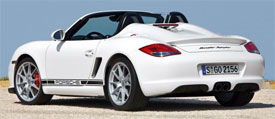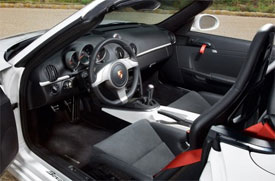2011 Porsche Boxster Spyder
Ever since the brash Cayenne utility hit dealers in 2003, Porsche purists have been understandably uneasy, and with the arrival of the front-engine, four-door Panacea earlier this year, perhaps more so now than ever. But the new Boxster Spyder should be reassuring. With bare bones styling from the iconic 550 Spyder, it’s a 100% classic, but modern, Porsche.
The Boxster’s basic sports car shape is becoming iconic in its own right, but the 2011 Porsche Boxster Spyder cranks it up a notch. Carrera GT-style twin-hump fairings aft of padded roll bars replace the Boxster’s simple deckled. A nicely done stoplight bridges the gap between the fairings.
And for even more fun, a Spartan two-piece manual soft-top gives the Boxster Spyder a definite ‘50s speedster look. And those vintage rocker panel stripes, especially on our sleek black tester, are easily as cool as the ones you get on the 911 GT3 RS. The stripes connect lightweight 19-inch alloy wheels that are unique to the Boxster Spyder.
The Spyder’s front fascia gets only a subtle freshening from the regular Boxster. While, out back, there’s a fixed spoiler and rear fascia borrowed from the Boxster S. But the Boxster sits 8/10ths of an inch lower than the S, and is 176 pounds lighter. Without the power top, and with new aluminum doors and trunk lid, the Spyder is the lightest of current Porsches.
Top down reveals much of the same cozy two-seat cockpit we’ve come to expect in a Boxster. But a closer look reveals red seatbelts, and more weight saving details like GT3RS-style pull-strap door releases, doors stripped of their storage bins, and a gauge cluster stripped of its shroud.
 Seriously track-ready Alcan Tara-trimmed, well-bolstered bucket seats prove more comfortable than they have any right to be. Radio and cupholders are no-cost options, but you’ll have to pay for the privilege of A/C. Like any Boxster, there’s meager trunk space split front and rear, displacing 9.9 cubic feet, total.
Seriously track-ready Alcan Tara-trimmed, well-bolstered bucket seats prove more comfortable than they have any right to be. Radio and cupholders are no-cost options, but you’ll have to pay for the privilege of A/C. Like any Boxster, there’s meager trunk space split front and rear, displacing 9.9 cubic feet, total.
The sole engine is a direct-injected 3.4-liter horizontally opposed six borrowed from the tintop Cayman S. Output is the same, at 320 horsepower and 273 pound-feet of torque. And we’ve gotta say, the Spyder’s exhaust note is pitch-perfect.
A six-speed manual transaxle is standard, but Porsche’s excellent seven-speed dual-clutch PDK automatic is a worthy, quick-shifting alternative. Both transmit power through a mechanical locking differential.
Running through our manual Spyder’s precise ratios at the track resulted in a 5.1-second sprint to 60. That’s the same as the last Boxster S we tested. A result we blame on our tester’s heavy option list. But the quarter mile arrived quicker—13.5 seconds at 106 miles per hour, even with an unavoidable last-minute shift into fourth gear.
The Spyder was much happier in the slalom. The Boxster’s mid-engined layout allows near perfect 50/50 front-to-rear weight distribution, and the Spyder adds to that a lower center of gravity, not to mention tires pumped to a lower PSI for more grip. The high-speed lane change couldn’t faze this chop-top Boxster, either. Inputs and outputs were near-telepathic. The Spyder is the best handling production Porsche we’ve ever driven.
 Braking was also impressive, with stops from 60 averaging a concise 113 feet with firm, short pedal travel and very little nosedive. Credit for all the fade-free stopping goes to our Spyder’s large rotors and four piston calipers.
Braking was also impressive, with stops from 60 averaging a concise 113 feet with firm, short pedal travel and very little nosedive. Credit for all the fade-free stopping goes to our Spyder’s large rotors and four piston calipers.
The Boxster Spyder’s short, stiff springs, anti-roll bars, and dampers tuned to near bone-jarring levels of sportiness never let you forget that this car is most at home on the track.
Government fuel economy ratings for the Boxster Spyder are as good or better than its less focused Boxster stablemates. The automatic rates 20 mpg city/29 highway, while the manual rates 19 city/27 highway. We averaged a respectable 23.9 miles per gallon on premium gas.
Including destination, the 2011 Porsche Boxster Spyder starts at $62,150. That’s four grand more than the much better equipped S. But then the Spyder is much rarer.
So, less car, but more performance, and more head turning, for more money. That’s the Porsche way, and we can’t help coming back for more. Plus, the 2011 Porsche Boxster Spyder is a total reassurance that Porsche is still committed to building true, and cozy, sports cars.
Specifications
- Engine: 3.4-Liter Six
- Horsepower: 320
- Torque: 273 Lb Feet
- 0-60 MPH: 5.1 Seconds
- 1/4 Mile: 13.5 Seconds @ 106 MPH
- 60-0 MPH: 113 Feet
- EPA: 19 MPG City/ 27 MPG Highway
- Mixed Loop: 23.9 MPG
2025 Volkswagen ID. Buzz
Volkswagen Brings Beetlemania Level Of Excitement To Minivan Segment
The duty of upholding Volkswagen’s heritage has most recently been delegated to small legacy car names like Golf and Jetta. But hold on! A much larger, totally modern take on VW’s classic microbus has just buzzed over the horizon— the all-electric ID. Buzz. It’s been at the top of our minds since we first saw the concept back in 2017. Well, it’s finally here, so let’s get our groove into drive!
This 2025 Volkswagen ID. Buzz has indeed created the most buzz around Volkswagen since the Beetle’s return to the U.S. in the late 1990s. We couldn’t drive it anywhere without drawing a crowd. No wonder, just about everyone has a VW Microbus story to tell, and seeing this reimagined version rolling down the street brings back all those memories.
VW really pulled it off as far as we’re concerned, as it looks great without appearing over the top. All the cues are here: Big VW logo front and center, lots of greenhouse including A-pillar windows and mini sliders for the second-row passengers, D-pillar air vents, and two-tone wheels. And while its appearance may be pure retro, its drivetrain is far from it, as the ID. Buzz is all-electric, and unlike the new Beetle, the Buzz does retain the original Microbus’ rear-drive architecture.
Powering those rear wheels is a 210-kW motor drawing juice from a 91-kWh battery for a range of 234 miles; 200-kW max charging will get you to 80% in about 26 minutes. Buyers can add another small 80-kW motor up front for 4motion all-wheel-drive and an increase of total output from 282 to 335 horsepower with a combined 512 lb-ft of torque. It uses the same battery, but range estimates drop just slightly to 231 miles. But while those numbers are modest, we also found them to be quite conservative, as we observed as many as 287 miles available in our all-wheel-drive tester’s gauge display and were on pace for 273 miles in our driving loop.
One throwback theme that may be a turnoff to some is that it’s quite a step up into the Buzz’s front seats, but there’s certainly a commanding view of the road once you climb in. Second row seating can be either a three-place bench or a pair of captain’s chairs, so there’s generous room for seven or six passengers. The captain’s chairs in our Pro S Plus offer good support and very easy access to the third row.
Lots of flexibility too with the option to simply fold the seats or remove them altogether.
With the sliding side doors and a wide opening rear hatch, there’s plenty of access for loading big sport utility amounts of cargo. Lots of flexibility too with the option to simply fold the seats or remove them altogether, and the ability to create a full-length flat floor with a rear cargo shelf that covers some handy removable storage bins. There’s 18.6 cubic-feet of space behind the third row, 75.5 behind the second, and a max of 145.5. That’s more than a Chevrolet Tahoe. For smaller items, there are lots of cubbies throughout the cabin, along with a standard Buzz Box that can be moved to multiple locations.
With a design that prioritizes retro form and modern function over aero efficiency, the 4motion equipped ID. Buzz earns a Fair efficiency rating, using 42-kWh of electricity per 100 miles, and we weren’t sure what to expect at our Mason Dixon test track.
What we found was great torque off the line and drama free launches to 60 in just 5.3 seconds. It was very stable at speed and power delivery stayed steady most of the way down the track until we reached about 90 mph, when it began to taper off just before we finished the quarter-mile in 14.0 seconds flat at 97 mph.
With 1,200-lbs. of battery weight nestled in its 127.5-inch wheelbase, the Buzz felt planted to the pavement through our handling course. There was quite a bit of body roll to deal with, but surprisingly little understeer. In panic braking runs, pedal response was inconsistent, feeling soft at times, pushing back hard at others; but through it all, results were quite good, stopping from 60 in an average of just 108 feet.
Three interior themes are available, this Dune is the brightest, featuring coastal inspired wood optic dash décor, “gray and clay” leatherette surfaces, and a high-mounted central 12.9-inch touchscreen. Pricing starts with a rear-wheel-drive Pro S at $61,545; this Pro S Plus begins at $65,045, add another $4,500 for 4motion, which brings a few extra features along with all-wheel drive.
Retro design with old-school VW charm, modern EV drivetrain, big SUV capacity merged with minivan flexibility; it all comes together in this 2025 Volkswagen ID. Buzz. It’s easily one of the coolest rides of the year and one that will likely keep Volkswagen dealers buzzing for years to come, and that’s something no other people and things mover can say.
Specifications
As Tested
- Motor Setup: Dual-Motor AWD
- Battery Size: 91-kWh
- Horsepower: 335
- Torque: 512 lb-ft
- EPA Range: 231 miles
- 0-60 mph: 5.3 seconds
- 1/4 Mile: 14.0 seconds at 97 mph
- Braking, 60-0: 108 feet
- MW Test Loop: ~ 273 miles













































